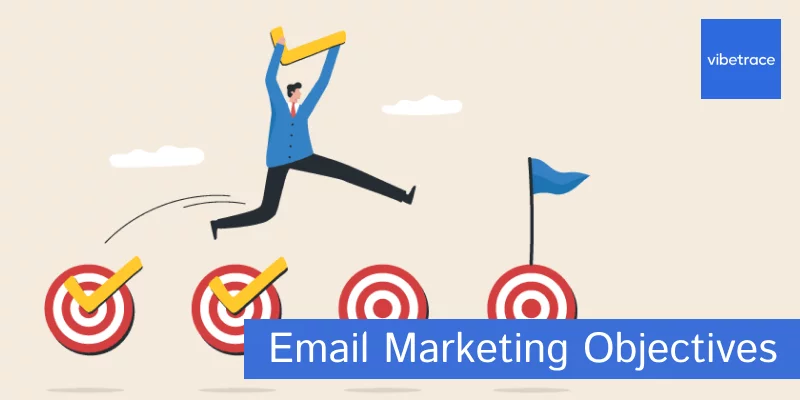Email campaign objectives support the overall direction of the marketing strategy. They frequently respond to the question, “What do you want to achieve with (this) specific email campaign?”
The objectives should be optimally tied to and matched with the company objectives.
Marketing objectives are narrower in scope and should be measurable, either through data, time frames, or both. In essence, marketing objectives are the actions that you and your marketing team perform to achieve your marketing goals.
Why is it important to have objectives in your business?
The essential thing to keep in mind while building a marketing strategy is the objectives that you want to rely on. It’s like having to organize a vacation or prepare supper for your family.
You must know what clothing to pack or whether one of them has a special allergy.
Similarly, it is hard to improve your plan to achieve the greatest outcomes if you do not have any marketing objectives.
Marketing objectives are designed to help you get the most out of your campaign and achieve your marketing goals, which are usually quite necessary to define before you begin executing things.
Your goals can also be established by using the SMART Objectives approach, which is designed to assist you in success and make your goals easier to monitor.
What are SMART Objectives?
Objectives will help in all aspects of business and life because they offer a feeling of direction, motivation, a clear focus, and clarity of priority.
By creating objectives, you give yourself a target to shoot for. A Smart objective is a type of objective that is used to help guide goal planning.
SMART is an acronym that stands for Specific, Measurable, Achievable, Realistic, and Timely.
As a result, a Smart objective integrates all of these factors to help focus your efforts and boost your chances of success. But what does exactly SMART stand for?
- Specific – Well-defined, clear, and unambiguous
- Measurable – With defined criteria that track your progress toward achieving the goal
- Achievable – Attainable yet not impossible
- Realistic -Within your grasp, reasonable, and pertinent to your life’s purpose
- Timely – With a clearly defined timeframe that includes a start date and an end date. The goal is to generate a sense of urgency.
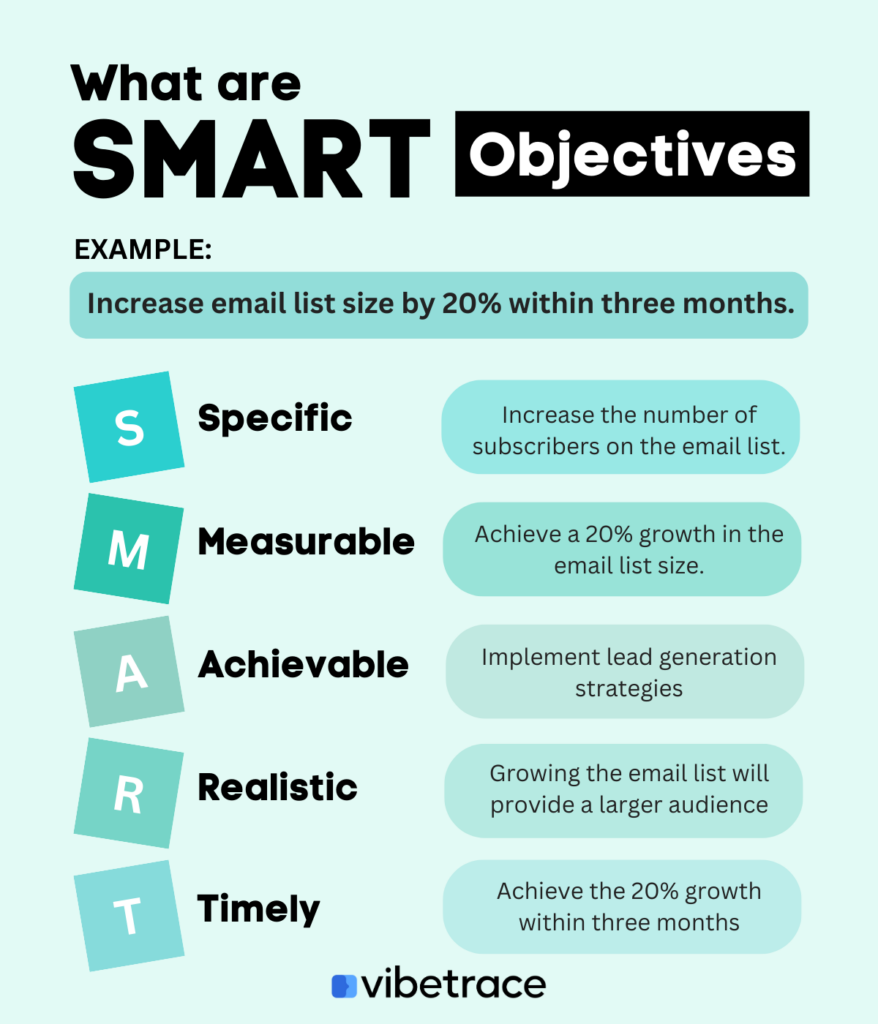
List of objectives you should really consider
Having an objective list may be your company’s first goal for the next year. We have for you a list of things to consider when building your strategy through objectives and aiming for better results.
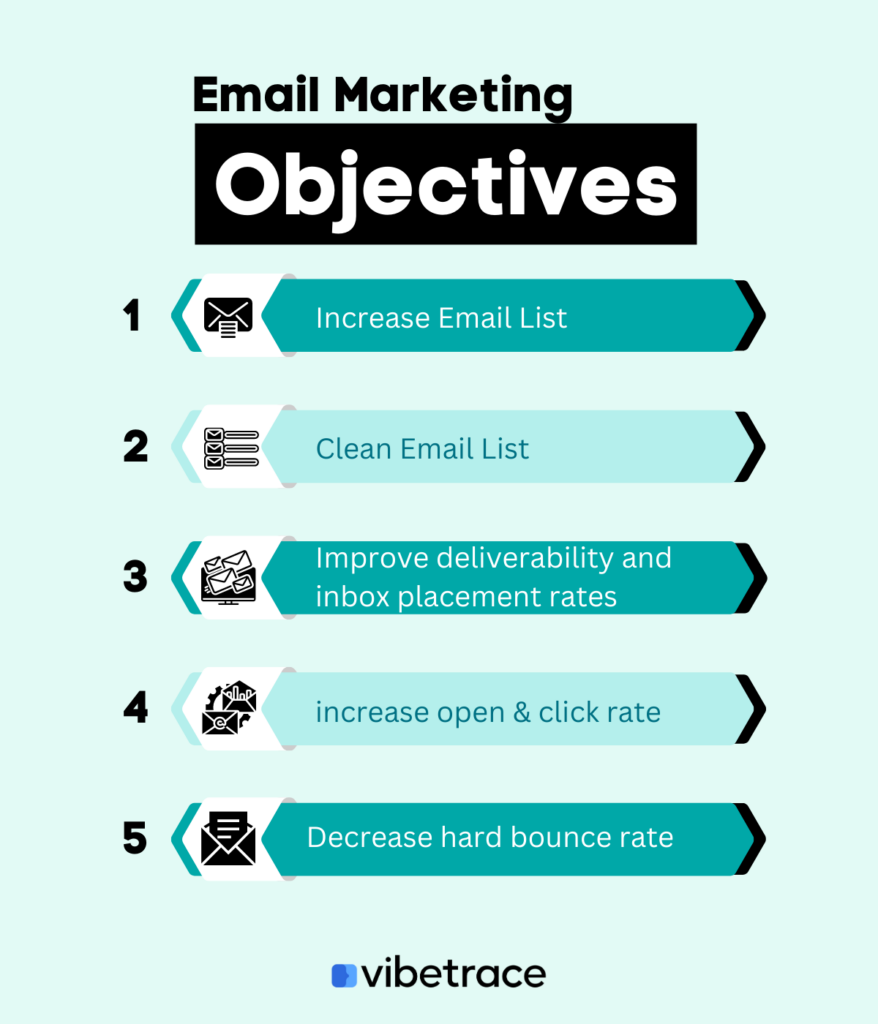
Increasing your email list size
While current marketing trends appear to be heavily focused on social media, research reveals that good old-fashioned email is still far more successful than popular platforms like Facebook and Instagram at acquiring online leads.
Email marketing offers one of the best returns on investment of any medium, with an average of $42 for every $1 invested.
If you are interested in growing your email list, check our blog on How to collect emails: Proven ways to grow your Email List and find what’s best for you and your business.
Example: Want to keep your current subscribers and have them assist you in growing your list? Make your email content stand out.
If your emails are fun, instructive, and valuable, readers will look forward to them and are more inclined to share them with their networks. This increases your exposure and leads to more subscriptions.
Also, read about Email List Growth Rate
Clean your email list
When cleaning an opted-in database, be attentive to your contacts’ choices and remove anyone who is no longer engaged with your emails. Cleaning an email list also entails removing incorrect information, which might include:
- Fake emails
- Invalid email addresses
- Typos
In most situations, marketers rely on Email Automation Software to handle these issues, which primarily assists them in tracking users and their activity and removing superfluous emails from their lists.
Did you know: Keeping unsubscribes to a minimum is the way to proceed. The larger your email list, the more likely it is that some people have lost interest in your email. It does happen.
Before they hit the unsubscribe button, it could be a good idea to check engagement and eliminate any subscribers who no longer appear interested.
Improve email deliverability and inbox placement rates
The ability to send emails to subscribers’ inboxes is referred to as email deliverability.
Some marketers use it to assess the chance of their email messages reaching their subscribers’ inboxes about real delivery–things like ISPs (Internet service providers), throttling, bounces, spam problems, and bulking.
Inbox placement refers to how frequently email is sent to the subscriber’s inbox rather than being retained or placed in a spam bin. It is a considerably more valuable number than the delivery rate because it provides a better indication of how much email is seen by subscribers.
The delivery rate just indicates that the email was accepted by an ISP(Internet service provider), whereas inbox placement gauges what they do with the email after it has been accepted.
Return Path estimates that only 82% of campaigns in the United States made it to the inbox. This means that approximately 1 in 6 emails are either being held, marked as spam, or otherwise not appearing in the recipient inbox.
Did you know: The method by which you acquire email addresses has a significant impact on your deliverability rates? Your email list will be full of engaged users if your opt-in procedure is optimized.
If you send an email to people who were unaware or did not consent to receive messages from you, they will mark your emails as spam, and ISPs will believe you are spamming everyone on your list (including those who want to get your email).
We propose using double opt-in, which requires two verifications from the user and is considerably more effective in growing an engaged email list.
Improve email marketing metrics: increase open & click rate
Open rate is a percentage that indicates how many successfully sent campaigns were accessed by recipients. Click rate is a percentage that indicates how many successful campaigns received at least a click from your target readers.
Open and click rates can provide a solid indication of how well your efforts are doing with a certain audience. If your open rate is high, it typically suggests your subject lines are appealing to your target audience.
If your click rates are high, the message content is pertinent to the users who open the email.
A thing that might affect your open rate happened during the 2021 Worldwide Developers Conference when Apple revealed its new Mail Privacy Protection for the Apple Mail app.
During the event, Apple announced the introduction of new tools to let users control and monitor how apps use their data, such as the ability to block email tracking in the Mail app. In other words, Apple Mail will not allow senders to see who opens their emails.
Did you know: Individual subscribers have different desires and needs. They fall into many categories and are motivated by a wide range of interests. When it comes to email open rates, one limiting element is the quality of the material in your emails.
Sending an email with insufficient information or no information of interest to those on your list will most probably result in your following emails going unopened.
According to Litmus, the subject line is the most important element in email openings for 34% of recipients. Indeed, 69% will designate an email as spam before opening it based just on the subject line.
The subject line influences email click-through rate, conversions, and, most crucially, unsubscribes.
We suggest you try:
- Creating email subject lines that pique people’s interest and entice them to open the email to learn more.
- Using urgency and instilling fear of missing out (FOMO).
- Posing questions.
- Incorporating emojis and symbols to make your emails stand out in the inbox and appear more interesting.
Decrease hard bounce rate
The email marketing bounce rate is a metric that estimates the number of emails that are returned to the sender. A high email bounce rate is enough to ruin all of your efforts.
What’s more frightening is that a high email bounce rate may result in your email-sending account being suspended or canceled.
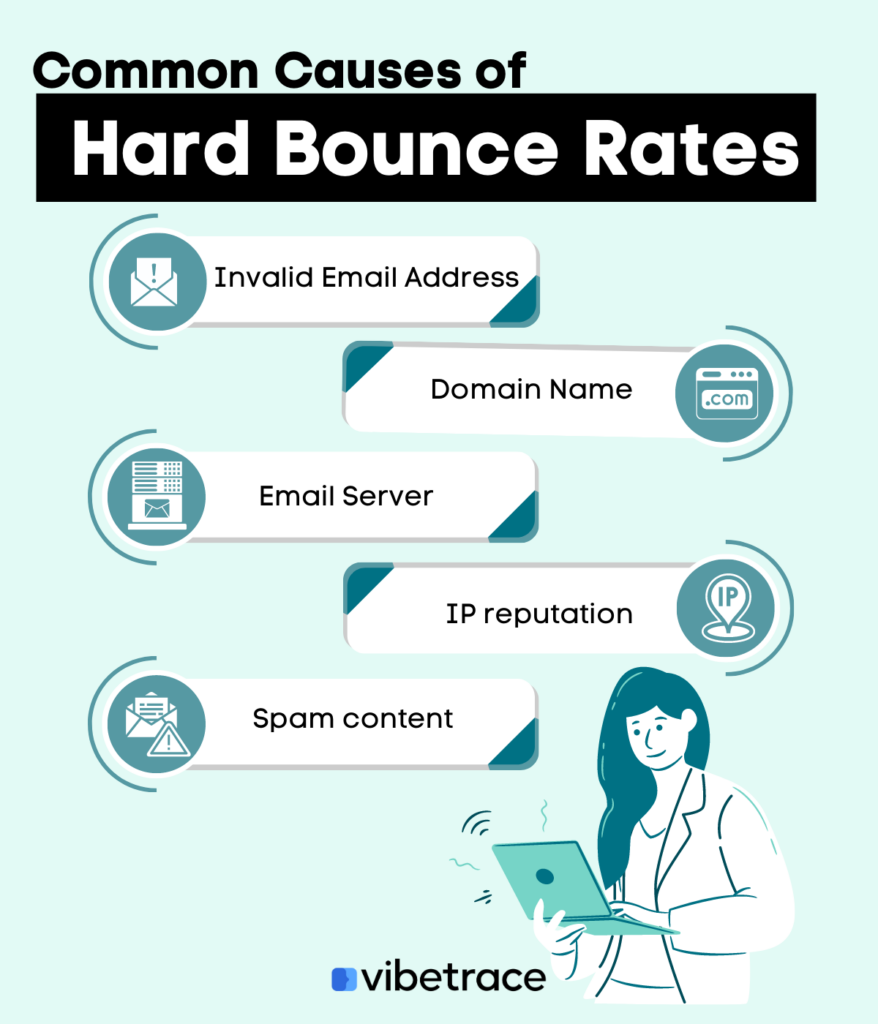
Some reasons that might result in a hard bounce rate are:
- Invalid Email Address – When the recipient’s email address is invalid, the email will be returned.
- Domain Name – There is no such thing as a domain name.
- Email Server – The email server of your prospect is preventing email delivery.
- IP reputation – The IP address from which the email was sent has a poor email-sending reputation, resulting in the email being rejected.
- Spam content — If your email subject or primary text contains spam-like features, the receivers’ email filter may have rejected the email.
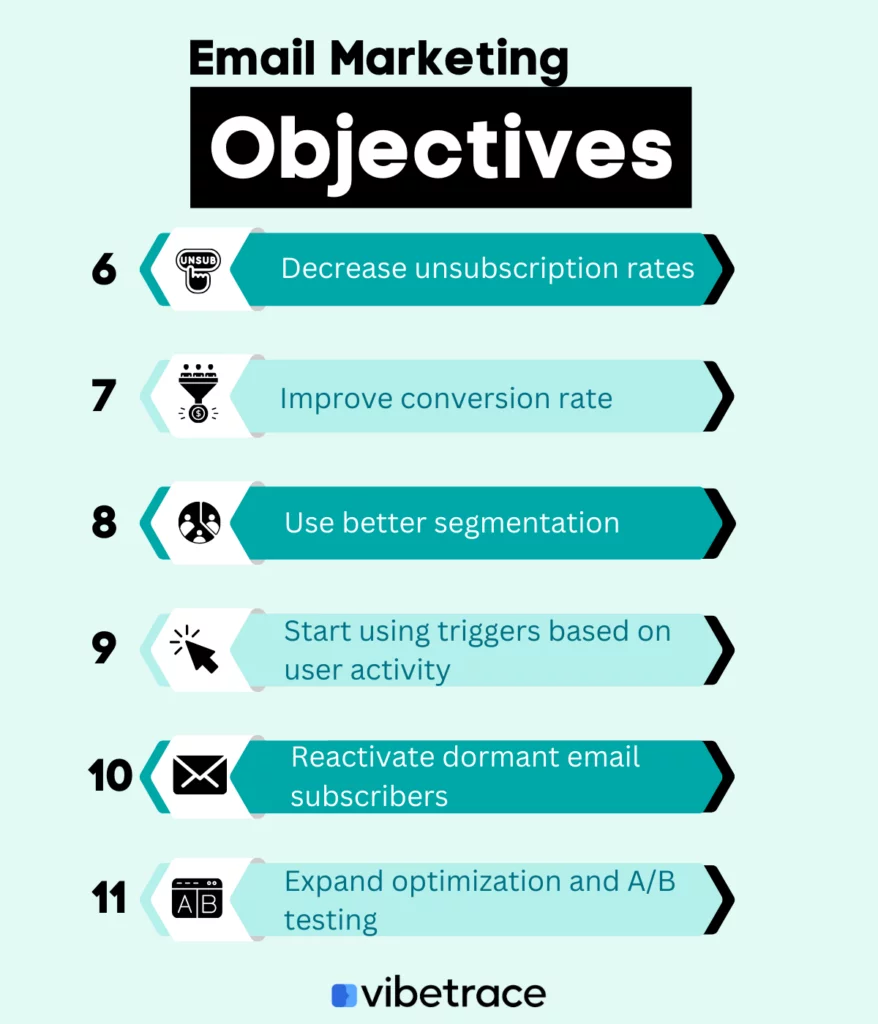
Decrease unsubscription rates
An unsubscribe rate is a metric that reflects the percentage of people that unsubscribe from a mailing list following an email campaign.
Because the unsubscribe rate affects email deliverability, a significant number of unsubscribers have a negative influence on email service providers such as Gmail, Yahoo, and Outlook.
Marketers track the unsubscribe rate, as well as other metrics like open rate and click-through rate, to determine the success of their email marketing strategies.
A high unsubscribe rate shows that certain aspects of your approach are lacking and that you should examine your email marketing more closely.
Perhaps your email sending volume is excessive, the content is unrelated to the expectations of your users, or your email templates are unprofessional and out of date.
Did you know: When a hard bounce happens, remove the address from your email list immediately and do not send to it again. Most email-deployment solutions eliminate hard bounces automatically.
However, it’s always a good idea to double-check that your platform is permanently deleting hard bounces since we’ve seen situations where this wasn’t happening as planned.
Send emails to your subscribers on a regular and consistent basis. By distributing to your list on a regular basis, you will not only see lower bounce rates but also fewer spam complaints and more subscriber engagement.
People’s email addresses inevitably change and old addresses are abandoned, resulting in email bounces. Contacting your subscribers on a regular basis, rather than infrequently, will assist prevent a large number of bounces from occurring at the same time.
Improve conversion rate from email
The percentage of subscribers that execute a target action after reading your email is your email marketing conversion rate. This is a key measure for most marketers since it defines the effectiveness of your email marketing and your return on investment.
Your subject line is the doorway to improved email conversions. It’s hard for individuals to perform the steps you would like them to take after reading your emails if they do not really open them.
Spend some time thinking about engaging topic lines, and don’t just throw them in as an accident.
Did you know: More emails are read on mobile devices than on any other sort of device nowadays, and this trend is not expected to change very soon. This fact alone should be enough to persuade you to consider optimizing your email campaigns.
Another important factor in increasing conversion rates is segmenting your email lists. The quality of your email lists have a significant impact on your open rates and, as a result, your conversion.
After you’ve segmented your list, you’ll need to figure out how to approach your subscribers in the most effective way. Your subject line, sender name, and the quality of your content will all influence how your receivers react to your campaign.
Use better segmentation instead of batch emailing
You’re undoubtedly aware that sending the same content to your whole email list with no segmentation or personalization isn’t the greatest method to reach out to your consumers.
Instead of inundating every one of your customers with the same email for your next major announcement, learn how to filter and segment your campaigns to target the correct audience at the right moment.
Did you know: Unless you’re delivering critical information to all of your subscribers, such as a policy change or corporate update, a better plan is to segment all of your emails sent to go to engaged subscribers and filter out people who haven’t read or clicked on an email from your brand in a long time.
One of the benefits of being a brand appreciator? Customers can get first glimpses and sneak peeks at your most interesting offers before the rest of the world.
Establishing a VIP category, whether clients are aware of it or not, is all about creating a sense of exclusivity. As a result, your most devoted clients will remain devoted and, perhaps, become brand ambassadors.
Start using triggers based on user activity
A trigger email is an automatic email that marketers send to clients to inform them and demonstrate that the firm to which they have subscribed is a trustworthy brand. A trigger email is a pre-programmed response to a subscriber’s specific activity or behavioral trend.
Sending triggered emails based on users behavior are important because they:
- Build trust
- Fulfill customers’ expectations
- Inform well
- Increase customer retention
Did you know: Triggered emails are commonly used in the following scenarios:
Product View Abandonment — If a client browses a specific item on a mobile app but does not purchase it, a triggered email showcasing the viewed product (along with other recommended items) will re-engage them after they exited the mobile app.
Cart Abandonment – For many eCommerce firms, shopping cart abandonment occurs when a customer adds items to their shopping cart but leaves without completing a purchase. You can send a cart abandonment email to try to entice them to finish their checkout process.
Order Confirmation – After a customer’s purchase order is confirmed and finalized, order confirmation emails are issued. Set the email trigger to convey order information, necessary shipping data, and more upon purchase completion.
Businesses may create a fantastic customer experience by engaging their customers with the correct message at the right time via triggered emails.
Want to be up to date with Marketing?
Subscribe to our Retail CX newsletter!

Stay connected with what’s really important to optimize your digital revenues.
By clicking the button, you accept our Terms & Conditions. Also you will need to confirm your email address.
Reactivate dormant email subscribers
What are dormant email subscribers? People who continue to be subscribed to our email lists with a legitimate email address but never open or engage with them.
The best approach to do this is to watch your metrics (opens and clicks) over time and then just look at the recipients who didn’t open their emails.
Perhaps the email address is inactive. Consider webmail addresses that were generated but are no longer in use (or very rarely). Another cause could be that the subscriber has lost interest.
Or perhaps he believes the quality of your emails has declined. There are a plethora of other probable explanations.
Did you know: Today, most email systems are built on triggers, events, customer lifecycle stages, and so on. In other words, the traditional batch and often ad hoc approach to email marketing is less prevalent than it formerly was.
Look at the different lifecycle stages and flows in which you lose attention and responsiveness in order to reactivate subscribers – or contacts – and even gain back unsubscribes.
Of course, with automated emails in specialized processes such as online purchasing, you should look at things like abandoned shopping carts, and everything you can track in order to understand the behavior of users and what drives them to lose interest.
Expand optimization and A/B testing
To maximize opportunity, broaden your optimization team’s A/B testing focus beyond the look and feel of your site. You must conduct further A/B testing by branching out into server-side optimization.
A/B tests new regions of your sites, such as search algorithms or new features, for example, to assist reduce risk.
Testing removes the uncertainty from website optimization and allows for data-driven decisions that alter company conversations from “we think” to “we know.” You can verify that every change provides positive results by measuring the impact of changes on your metrics.
Did you know: The following are some of the topics we recommend evaluating with A/B testing: subject lines, length, word order, content, personalization, visuals, and many more.
You should also examine the following testing statistics: Brands split on split testing and Small changes can have a large impact.
Make a hypothesis about how to improve your campaign, put it up as an A/B test, send it, and see what occurs. If you don’t see an increase in opens or click-throughs, you’ll learn something about your audience that will help you develop stronger campaigns in the future.
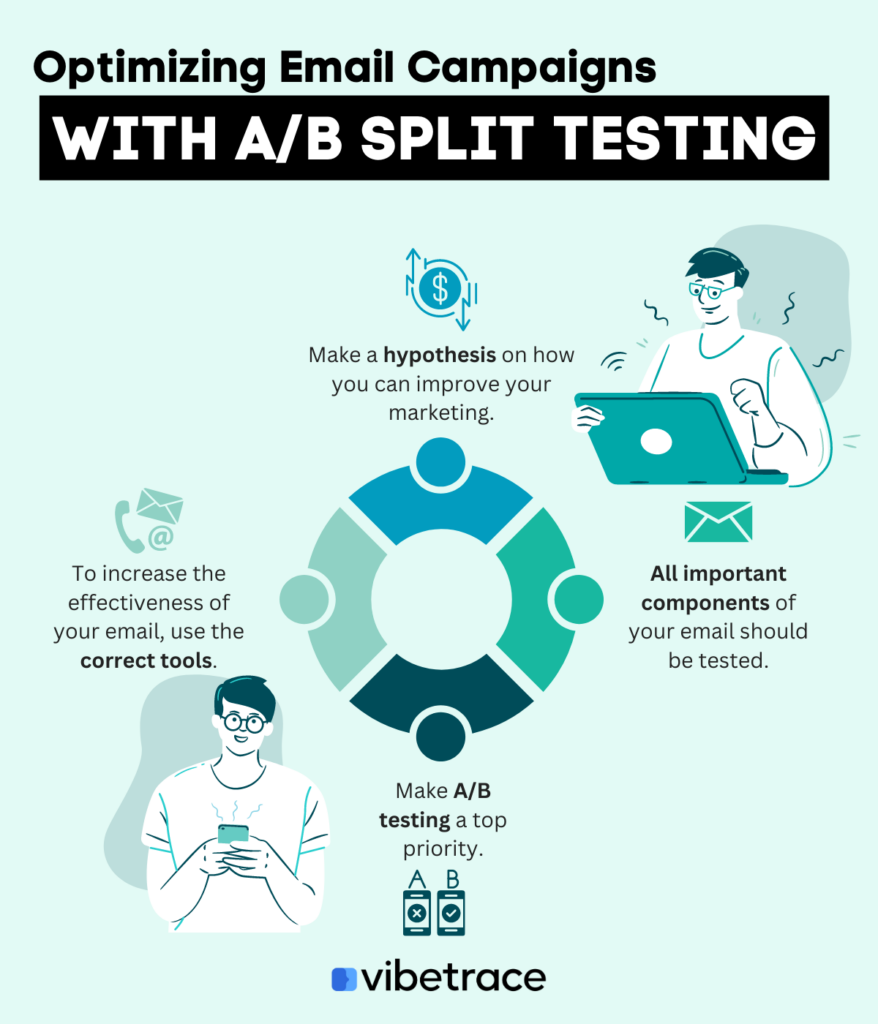
Here are some things to keep in mind when using A/B split testing to optimize your email campaigns:
- Make a hypothesis on how you can improve your marketing.
- All important components of your email should be tested.
- To increase the effectiveness of your email, use the correct tools.
- Make A/B testing a top priority.
Now that you know…
Track your progress toward your goals regularly by checking in and noting what you can do to attain each milestone more successfully. Setting company objectives can be thrilling.
You may have visions of something now, but a few weeks from now, you may not have a clear understanding of how far ahead you are in achieving your goals.
A lack of clarity might lead to the abandonment of goals. If you want to revolutionize your firm, you must track your progress toward attaining your goals.
If you found this blog useful, don’t hesitate to read our prior blogs and share your thoughts in the comments!

